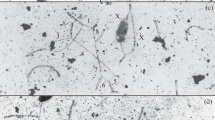Abstract
Information obtained previously and presently on chromosome pairing and chiasma formation in trisomics and in interchange heterozygotes has been applied in newly constructed models for calculating expected MI configuration frequencies in interchange trisomics. Good fit betwen calculated and observed frequencies in some and poor fit in other cases confirmed the expectation of genetic variation in the crossing-over potentials of some or all chromosome regions. If conclusions in respect of chromosome pairing pattern are to be based on relative frequencies of MI configurations, valid values for crossing-over potentials are required. These can only be obtained from genetically comparable material. A few more disturbing factors are recognised. Environmental effects are one of these factors but may have a relatively simple character. Good agreement between expected and observed frequencies of configurations was taken to indicate the validity of the assumption that homologous chromosome end segments have equal probability of being involved in pairing, irrespective of the length of the segment. This conclusion was confirmed by the segregation of chromosomal types in the progenies of interchange trisomics: the excess chromosome was combined as frequently with the interchange set and with the normal set respectively, as expected on basis of the same models, assuming 60–80% viability of trisomes compared to diploids.
Similar content being viewed by others
References
Ahloowalia, B. S. (1963). Study of a translocation in tetraploid rye.Genetica 33: 207–221.
Darlington, C. D. (1937). Recent Advances in Cytology. J. & A. Churchill Ltd., London.
Doyle, G. G. (1963). Preferential pairing in structural heterozygotes ofZea mays.Genetics 48: 1011–1027.
Grell, E. H. (1961). Variations in preferential segregation on chromosome two in triploid females ofDrosophila melanogaster.Genetics 46: 1267–1271.
Håkansson, A. (1940). Eine tertiäre Trisome vonGodetia Whitneyi.Botaniska Notiser: 395–398.
Linnert, G. (1962). Untersuchungen an hemiploiden Nachkommen Autotetraploider. I. Der Verteilungsmodus einer reziproken Translokation und die daraus folgenden Erhöhung der Heterozygotenfrequenz in der Nachkommenschaft von Duplex-Heterozygoten.Z. Vererbungslehre 93: 389–398.
Shaver, D. L. (1963). The effect of structural heterozygosity on the degree of preferential pairing in autotetraploids ofZea.Genetics 48: 515–524.
Sutton, E. (1939). Trisomes in Pisum sativum derived from an interchange heterozygote.J. of Genetics 38: 459–476.
Sybenga, J. (1958). Inbreeding effects in rye.Z. Vererbungslehre 89: 338–354.
Sybenga, J. (1965a). The quantitative analysis of chromosome pairing and chiasma formation based on the relative frequencies of M I configurations. I. Introduction: normal diploids.Genetica 36: 243–252.
Sybenga, J. (1965b).Idem..Genetica 36: 339–350.
Sybenga, J. (1965c).Idem..Genetical 36: 351–361.
Sybenga, J. (1966a).Idem..Genetica 37: 199–206.
Sybenga, J. (1966b). The zygomere as hypothetical unit of chromosome pairing initiation.Genetica 37: 186–198.
Sybenga, J. (1966c). Reciprocal translocations and preferential pairing in autotetraploid rye. In:Chromosome Today I (Ed. C. D. Darlington & K. R. Lewis): 66–70. Oliver & Boyd, Edinburgh & London.
Sybenga, J. (1966d). The role of meiotic chromosome pairing pattern in induced structural allopolyploidization of autopolyploids.Proceedings IV Eucarpia Congress, Lund 1965. In press.
Author information
Authors and Affiliations
Rights and permissions
About this article
Cite this article
Sybenga, J. The quantitative analysis of chromosome pairing and chiasma formation based on the relative frequencies of MI configurations. V. Interchange trisomics. Genetica 37, 481–510 (1966). https://doi.org/10.1007/BF01547150
Received:
Issue Date:
DOI: https://doi.org/10.1007/BF01547150




